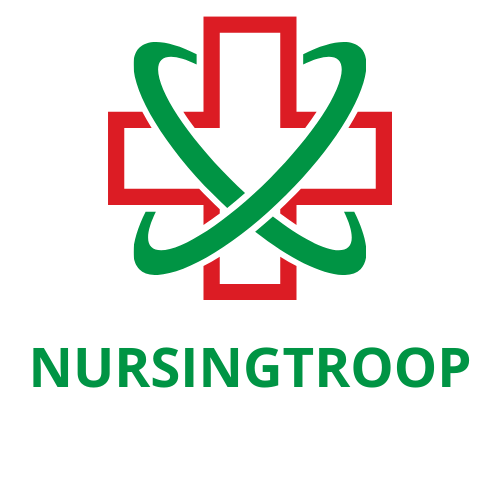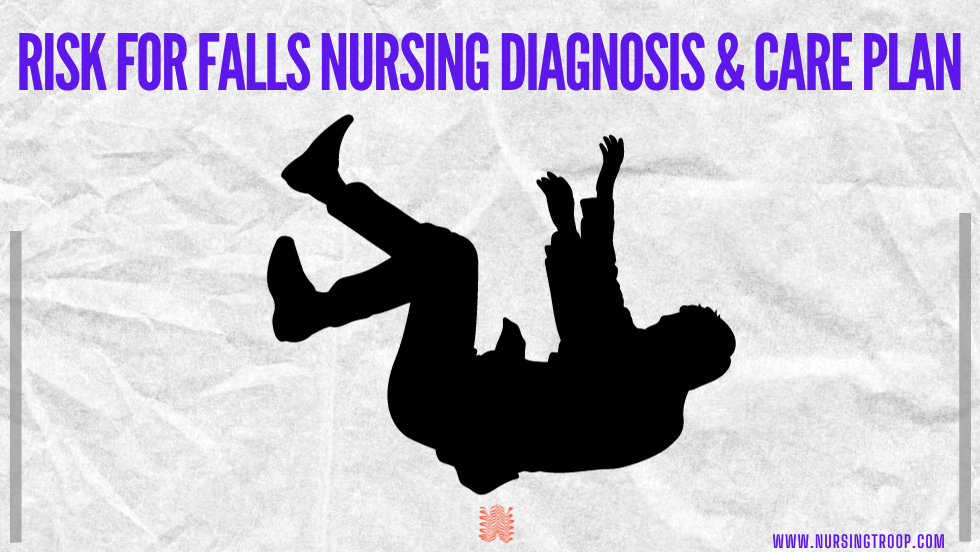Fall-related injuries and deaths are the fifth leading cause of death in adults over 65. As defined by NANDA International (NANDA), the risk for falls is an actual or potential medical diagnosis experienced by seniors and other high-risk populations.
Nursing care plans should be individualized to each patient’s specific risks, with interventions implemented that can help reduce their chances of experiencing a fall.
This blog post focuses on the nursing diagnosis at risk for falls, including its definition, nursing assessment data to consider when diagnosing this risk factor, goals for care planning related to reducing fall risk, and targeted interventions you can implement.
Table of Contents
What is Fall Risk?
Fall risk is a term that refers to the probability or chance of an individual experiencing a fall. It is usually associated with older adults, who are more prone to falls as their bodies weaken. Four main systems control balance and prevent falling: visual, vestibular, somatosensory, and musculoskeletal.
Balance Sensors
- Brain
- Eyes
- Inner Ear
- Muscles
- Joints
- Sense of Touch
However, fall risk can affect individuals of all ages and conditions, from children to athletes to hospital patients. Fall risk nursing diagnosis is essential in differentiating fall risks and treating underlying conditions.
Factors Contributing to a Fall
Falls are caused by a loss of balance or the inability to regain balance. However, the contributors to this are complex.
Four categories represent the factors that contribute to a loss of balance:
- biological
- behavioral
- social/economic
- environmental factors
The risk of falling for an older person increases by almost 80% when four or more factors are present as risk compounds.
Biological Factors
Biological risk factors are associated with the body’s natural aging process and acute or chronic health problems. These include advanced age, reduced mobility and balance, muscle weakness, poor eyesight, chronic illness, and disability (such as cognitive impairment or stroke). At the same time, some aspects of these risks cannot be changed. For instance, gender or age – others can be prevented or compensated for, such as muscle weakness or poor vision.
Additionally, lifestyle choices can increase the risk of developing certain biological conditions, such as poor diet, lack of exercise, and smoking. Maintaining a healthy lifestyle can help reduce risks, prevent the onset of age-related diseases, and improve overall physical health.
Behavioral Factors
Behavioral risk factors refer to the actions taken, or lack thereof, that can increase the chances of falls. Common behavioral fall risks include:
- Poor diet and nutrition
- Lack of physical activity
- Alcohol consumption
- Medication side effects/interactions
- Environmental hazards
Social/Economic Factors
Social and economic factors can increase the risk of falls. These factors include:
- Poverty
- Low social support/ isolation
- Language barriers
- Lack of access to care
Environmental Factors
Environmental risk factors are related to the home and community environment and can contribute to falls in various ways. These factors include:
- Inadequate lighting
- Poorly maintained walking surfaces
- Loose electrical cords
- Improper use of assistive devices.
Data & Stats
Falls are the leading cause of death among adults aged 65 and over, resulting in more than 34,000 fatalities annually. Globally, falls are the second leading cause of unintentional injury-related deaths. In the United States, fall death rates have risen by 30% between 2007 and 2016—and this rate is projected to result in seven fall deaths every hour by 2030. Injuries from falls can be costly and lead to prolonged hospitalization for older individuals.
In 2015 alone, it was estimated that medical costs due to falling totaled over $50 billion, with 3 million emergency room visits as a result. On top of this, people’s quality of life is drastically altered after sustaining a fall-related injury. Falls are the most common cause of traumatic brain injuries (TBI) and hip fractures. Every year, over 800,000 patients are hospitalized due to falls.
Nursing Risk for Falls Care Plan
Nursing Assessment for Risk for Falls
- Physical Assessment – assess for mobility, strength, coordination, and range of motion.
- Cognitive Status – assess for clarity of thought and memory issues
- Medication Review – review all medications for potential side effects that could increase the risk of falls
- Environmental Evaluation – check the home environment to identify hazards that can increase fall risk.
- Social & Economic Risk Factors– Identify and address social or economic factors that might contribute to the risk of falling.
Risk For Falls Nursing Diagnosis
- Impairment of balance/musculoskeletal system secondary to neurologic disease, weakened muscles, and joint stiffness
- Visual disturbances secondary to cataracts, macular degeneration, or diabetic retinopathy
- Reduced sensation in lower extremities secondary to peripheral neuropathy
- Impaired ability to ambulate safely due to weakened muscles and neurologic disease
- Side effects of medications such as dizziness, confusion, drowsiness
- Environmental hazards such as slippery floors and cluttered areas
- Fear of falling/inability to recognize hazards due to cognitive deficits
Goals for Care Planning Related to Reducing Fall Risks
- To improve muscle strength and balance
- To improve mobility
- To reduce the risk of falls in the home environment
- To identify fall risks in the community/public environments
- To minimize any side effects from medications that can increase fall risks.
Interventions for Reducing Fall Risk
- Exercise – Encourage regular exercise to improve muscle strength, coordination, balance, and flexibility.
- Home Safety Measures – Provide instruction about eliminating environmental hazards present in the home, such as loose carpets or electrical cords. Provide lighting solutions for better visibility.
- Medication Review – Regularly review the medication list with the physician or pharmacist to minimize potential side effects that could contribute to falling.
- Assistive Devices – Provide instruction in using any assistive devices that might be needed, such as a walker or cane.
- Education – Educate patient and family members about fall prevention strategies, such as changing body position quickly if falling is imminent.
- Community Resources – Connect patients with community resources that can provide additional assistance for fall prevention.
Follow-up Care
It is essential to follow up care with patients at risk for falling to ensure that the goals have been met and any new risks have been identified. Follow-up care may include physical therapy to improve mobility and strength, home safety checks, medication reviews, and assessments of cognitive function.
Additionally, follow-up visits should assess the effectiveness of any assistive devices provided and review fall prevention strategies. Follow-up care is essential to reducing the risk of falls and ensuring that older individuals remain safe, healthy, and independent.
Prevention
Preventing falls is essential for reducing the burden of fall-related injuries and fatalities. Prevention strategies focus on identifying risk factors and implementing measures to reduce or eliminate those risks. Common prevention strategies include:
- Exercise – regular exercise can improve muscle strength, coordination, balance, and flexibility
- Medication Review – review the medication list with a physician or pharmacist to identify potential side effects that could increase fall risk
- Home Safety Measures – inspect the home environment for hazards that could lead to falls (loose rugs, uneven surfaces)
- Assistive Devices – provide instruction in the proper use of assistive devices such as walkers and canes
- Education – educate patient/family members about fall prevention strategies, such as how to change body position quickly if falling is imminent
- Community Resources – connect patients with community resources that can provide additional assistance for fall prevention.
By identifying risk factors and taking proactive steps to reduce the potential of falls, older individuals can remain safe, healthy, and independent for longer.
Frequently Asked Question
How do you write a risk for nursing diagnosis in Nanda?
When formulating a risk diagnosis, the prescribed formula is as follows:
Risk for_____as evidenced by_____(Risk Factors).
NANDA International standardizes nursing terminology, mainly focusing on nursing diagnoses.
What is a nursing diagnosis for fall risk?
The Morse Fall Scale assesses risk factors for potential falls in hospitalized patients. It evaluates history of falling, secondary diagnosis (or more), ambulatory aids, IV therapy, gait, and mental status. A score of “0” indicates no risk for falls, while a score >45 indicates high risk, with a low to moderate risk falling in between.
Final Words
Falls are a serious issue among older adults, resulting in death and disability yearly. It is essential that risk factors be identified and preventive measures taken to reduce the number of falls and associated injuries/deaths.
Through a comprehensive assessment process, healthcare providers can identify these fall risks and develop comprehensive care plans aimed at reducing those risks.
Additionally, preventative strategies such as exercise, home safety measures, medication reviews, and community resources can help reduce fall risk. Through these strategies, older individuals can remain safe and independent for longer.
References
- https://www.who.int/news-room/fact-sheets/detail/falls
- https://www.cdc.gov/falls/index.html
- https://en.wikipedia.org/wiki/Falls_in_older_adults
Mrs. Marie Brown has been a registered nurse for over 25 years. She began her nursing career at a Level I Trauma Center in downtown Chicago, Illinois. There she worked in the Emergency Department and on the Surgical Intensive Care Unit. After several years, she moved to the Midwest and continued her nursing career in a critical care setting. For the last 10 years of her nursing career, Mrs. Brown worked as a flight nurse with an air ambulance service. During this time, she cared for patients throughout the United States.

